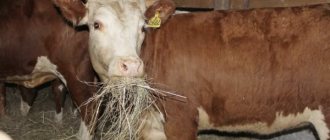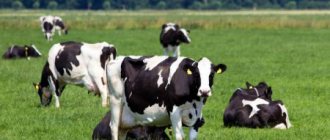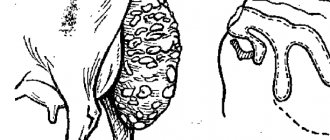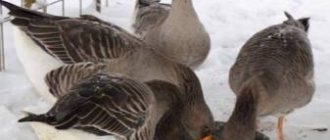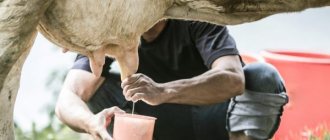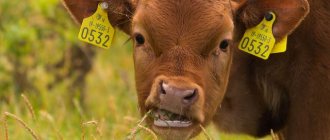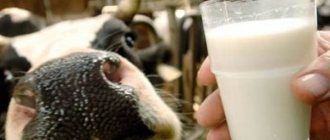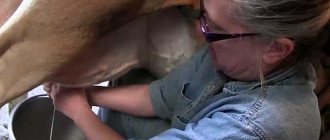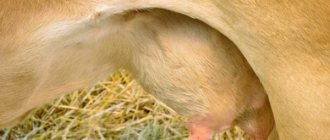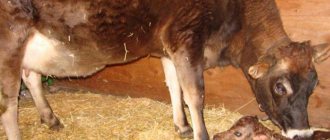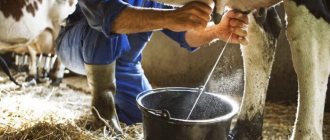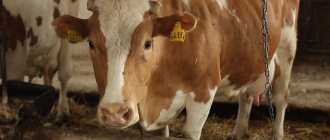What causes the delay?
Many literary sources write that the release of membranes after calving should occur in a cow no later than 12 hours, while a delay in the release of the placenta by 8-9 hours, in most cases, requires the intervention of a specialist. In old-time cows and those bearing several calves at once, this time can be extended to 16 hours.
The reasons why the placenta does not come off on its own may be as follows:
- insufficient tone of the uterus or complete cessation of contractions of the organ - occurs due to insufficient physical activity of the cow. If an animal walks less than 10 kilometers a day, muscle tissue, including the uterine tissue, relaxes. As a result, the organ cannot independently expel the membranes;
- obesity and metabolic disorders – observed as a result of overfeeding, the predominance of sour pulp, fermented corn grain, and silage in the cow’s diet;
- deficiency of vitamins and nutrients - calcium, phosphorus, selenium and vitamin E;
- protracted labor - more often the placenta does not pass away on its own if two calves are born or one, but too large fetus, especially if it is not located correctly in the uterus;
- too frequent childbirth, leading to excessive stretching of the muscles of the uterine walls;
- systemic diseases (brucellosis, vibriosis) causing caruncle turgor;
- infectious pathologies in the tissues of the uterus and amniotic fluid (chorion), leading to fusion of the fetal part with the maternal part of the placenta.
In order for the placenta to pass on its own, the full maturity of the placenta is important. With a lack of the hormone estrogen, which is responsible for the maturation of placental tissue, problems arise with the separation of membranes, more often in young cows and first-calf heifers.
How to separate a cow's afterbirth yourself
If the birth is over, and the cow still could not remove the placenta on her own, it is possible to do this with your help. Such extreme measures should be taken in rare cases: for example, when childbirth occurs at night or the weather does not allow a specialist to reach you. So, let's look at how you can help the animal.
Conservative method of placenta separation
This method involves the use of medications—they should be stocked up during the initial stages of a cow’s pregnancy:
- Prostaglandins F2. Improves uterine contractions. It is necessary to administer 2 ml intramuscularly.
- "Oxytocin." Improves uterine contractions, increases myometrial tone. Use 50 units subcutaneously (the dosage should be discussed with your veterinarian in advance; it can range from 30 to 60 units).
- "Pituitrin." Has the same effect as other drugs. 8–10 units are administered subcutaneously. The dosage is approved in advance with a specialist.
Among the tablets that have a broad effect, the following are injected into the uterus:
- "Exuter" (2–5 pieces);
- "Septometrin" (3 capsules);
- furazolidone suppositories (from 2 to 5 pieces).
Signs and symptoms
If the placenta does not come out on its own within the required time, it is important to call a veterinarian who will perform an examination and note warning signs:
- the animal looks tired and depressed, refuses food and water;
- the cow's temperature rises;
- the animal hunches over and arches its back;
- there are regular attempts similar to the urge to urinate;
- The cow's milk supply decreases.
When the placenta has not completely passed away, and large pieces of the fetal membrane remain in the uterus, after 1-2 days they will begin to decompose due to the proliferation of pathogenic microorganisms inside the organ. The cow begins to have a mucous-bloody discharge, sometimes mixed with pus, which has a strong, unpleasant odor.
Diagnostics
Early diagnosis of placenta retention helps to avoid the development of a severe inflammatory process in the birth canal. How to detect pathology in time? It is important for the farmer to be present at calving and for some time after the calf is born to monitor the condition of the heifer. If the separation of the placenta does not occur within 6-8 hours after birth, it is better to contact a veterinary service. The cow needs to be examined. The difficulty of diagnosis lies in the fact that some animals tend to eat the afterbirth. That is, its absence does not necessarily mean that it has not left the birth canal.
To dispel doubts, it is necessary to examine the uterine cavity. With some experience, a farmer can do this on his own. Wearing sterile high gloves, a person should insert his hand into the animal’s vagina and carefully examine the parietal region of the uterus. If suspicious clots or membranes or their fragments are found there, a diagnosis is made of retained placenta.
Partial release of the child's place is diagnosed by visual inspection. In this case, its fragments are usually visible from the vagina. They are painted red or gray.
Diagnostic measures
The veterinarian can diagnose that the placenta could not pass away on its own based on the characteristic clinical picture. It is necessary to palpate the uterine cavity and vagina.
Expert opinion
Zarechny Maxim Valerievich
Agronomist with 12 years of experience. Our best country expert.
Ask a Question
It is possible to confirm that the uterus has not been cleared of membranes, and the inflammatory process has begun, using a laboratory blood test - pronounced leukocytosis and an increase in ESR will indicate an incipient infection. If necessary, histological and cytological examination of placental tissue is carried out.
Manual extraction
Such an intervention can only be used if other methods have failed. With it, all manipulations in the uterus must be carried out under epidural anesthesia and in compliance with all sterility rules. If you introduce an infection, it will cause no less harm than the remaining placenta.
Read also: Saanen dairy goats
When the placenta remains in the genital tract due to insufficient uterine contractions and is no longer connected to the uterus, it is simply carefully pulled out. This is completely safe and painless for the cow and does not cause bleeding.
When the placenta remains attached, you cannot pull it, and you should first try massaging the uterus with your fist. This allows you to activate muscle contractions, which speeds up the separation of the placenta. If there is no result after manual massage, then they try to separate the afterbirth from the cow with their fingers, carefully tearing it away from the wall. At the same time, the released part of the placenta is twisted around an axis, which helps intrauterine manipulation.
As soon as the separation is made, antibiotic solutions are injected into the uterine cavity to prevent infection of the wound surface. Next, the animal needs to be given more attention than usual, carefully monitoring its condition. If it changes for the worse, you need to urgently contact a veterinarian.
Treatment methods
Starting treatment in the early postpartum period, if the placenta has not separated on its own, will prevent negative consequences for the health of the cow and quickly give a positive effect. The animal needs quality care, feeding, and plenty of clean water.
See also
Average life expectancy of wild bulls and how many years people keep themRead
First of all, conservative therapy is used, aimed at self-separation of the remnants of the placenta. It begins within 8-16 hours after calving. If the birth was difficult, it is recommended to start drug treatment immediately, without waiting for complications. Only if it is ineffective is manual cleaning of the uterus indicated.
Operation
If the placenta still does not come out on its own within 16 hours after calving, and conservative therapy does not produce positive results, it is necessary to select placental tissue from the uterus manually. This should only be done by a specialist. It is recommended to collect the placenta 2-3 days after calving, since it will be problematic to do this earlier and the risk of developing postpartum hemorrhage increases.
You should also not delay cleaning longer, since the decomposition of the membranes will cause general intoxication of the animal’s body.
Even with a highly qualified veterinarian, he is not always able to completely remove the remnants of the placenta, which is why the cow has to be treated with antibacterial and anti-inflammatory drugs in the future. After manual cleaning of the uterus, the animal is shown antibiotics injected into the organ:
- "Penocefur" is a third generation antibiotic with a broad spectrum of action. Forms foam that destroys pathogenic microflora. Has a minimal number of side effects, does not affect the quality and quantity of milk;
- "Carotyl" is an intrauterine antimicrobial agent with bacteriostatic and antioxidant properties. The substances included in the drug help reduce inflammation and accelerate tissue healing.
Immediately after the operation, it is important to prevent intoxication and inject the animal intravenously with 200 milliliters of 40% glucose and 200 milliliters of 10% calcium chloride solution. To improve the discharge of lochia, you can do a rectal massage of the uterus.
Medicines
Even with the veterinarian’s efforts to remove the placenta completely, this is not always possible, which can lead to endometritis. Immediately after cleaning the uterus, 3-4 suppositories with disinfecting properties must be introduced into the organ cavity:
- "Iodopen";
- "Gynobiotic";
- "Metromax";
- "Nifumen";
- "Enroflon".
Intrauterine drugs must be administered twice a day until the cervix closes, making the use of such drugs no longer possible.
The drug “Ikhglukovit” has a good antimicrobial effect - it is administered by injection, in addition to drugs in the form of suppositories and vaginal tablets. A single dosage is 40 milliliters, divided into two injections (20 milliliters on each side from the base of the cow's tail into the paravaginal tissue and pelvic cavity). The product is used every other day until the foul-smelling discharge completely disappears (on average, 7-10 days).
Hormonal agents
It is recommended to use hormonal drugs before manual intervention to cleanse the uterus, when the placenta does not separate on its own within the prescribed time. The main hormonal agent that helps in the expulsion of the membranes is Oxytocin. At a dose of 50 milliliters, it promotes contraction of the uterine muscles and separation of the remnants of the placenta with their subsequent release to the outside.
Another effective hormonal drug is Magestrophan. The substance it contains, cloprostenol (a synthetic analogue of prostaglandin F2a), promotes rapid resorption of the corpus luteum formed during pregnancy and increased contractile activity of the uterus. Dosage for a cow – 3-4 milliliters 6-12 hours after calving.
The drug "Uterobag", used to improve the discharge of the placenta, contains propranolol hydrochloride, which affects endogenous oxytocin. An increase in hormone levels leads to uterine contractions and expulsion of the placenta. To achieve the effect, “Uterobag” is injected into a vein three times at intervals of 12 hours.
When the uterus independently cleans itself of the remnants of the placenta, Endometramag Green liquid suppositories are injected intrauterinely in a dosage of 150 milliliters. The product effectively suppresses viral, fungal and bacterial flora, preventing further infection of the uterus and the development of the inflammatory process.
See also
Top 2 ways to determine the age of a cow and other cattleRead
Antibiotics
Antibacterial drugs are used to remove an acute inflammatory process in the uterus, accompanied by an increase in the animal’s temperature, the release of foul mucus with purulent inclusions, and also after manual cleaning of the uterus. Modern, cattle-safe means:
- "Ceftiomax" is a broad-spectrum drug from the group of third-generation cephalosporins. Effectively acts on the most common pathogens of necrobacteriosis and causing the development of post-calving endometritis. The dosage is selected based on the cow’s body weight - 1 milliliter per 50 kilograms of weight. One injection is given per day, the course of treatment is 5-7 days;
- "Bicillin 3" is an antibiotic from the group of semisynthetic penicillins. An adult cow is administered 10,000 units once every 3 days for two weeks;
- "Ceftimag" is a drug based on ceftiofur, a third generation cephalosporin. If the placenta is not cleared after calving and endometritis develops, the drug is administered once daily in a course of 3-5 days at the rate of 1 milliliter per 100 kilograms of weight.
There is no need to try to give the cow an antibiotic in the form of tablets - the animal will not eat the bitter medicine, and its condition may worsen by the development of digestive disorders and diarrhea.
Folk recipes
To make the afterbirth easier to separate, traditional methods are also used if the cow’s owner does not have the opportunity to call a veterinarian for help:
- frequent milking of a cow - helps to increase the level of oxytocin, which is responsible for the contractility of the uterus;
- feeding the animal a sweet solution - 400 grams of sugar diluted in a liter of water (the cow must drink at least 2 liters of liquid);
- collecting amniotic fluid and feeding it to the cow - substances present in the fluid increase the activity of uterine contractions and facilitate the passage of the placenta.
In difficult situations, when the health and life of the cow is in danger, it is better not to use folk remedies, but to contact an experienced veterinarian for an emergency solution to the problem.
Prevention
To prevent your animal from being stressed after birth due to retained placenta, preventive measures must be taken.
These include:
- Regular walking.
- Balanced diet.
- Frequent examination by a veterinarian.
- Maintaining cleanliness in the stall.
- Administration of vitamins every 10 days during the last month of pregnancy.
If all recommendations are followed, the likelihood that calving will take place without complications is very high.
Therefore, monitor the animal and follow all the rules of care, especially during pregnancy, so that both the cow and the calf are healthy. Source
Preventive measures
To ensure that cows do not have problems with the passage of the placenta, it is important to observe prevention - to avoid causes that provoke weak labor and retained membranes. It is necessary to follow a proper diet, enriched with vitamins and minerals, and graze the animals daily, giving them the opportunity to actively move.
You can introduce additional portions of vitamin E by injection or as part of the feed, but not during the dry period, so as not to provoke placental abruption and oxygen starvation of the calf.
Delayed or incomplete passage of the placenta is a common problem among cows, which, in the absence of timely treatment, negatively affects reproductive function. Prevention of labor disorders and high-quality complex therapy help prevent serious complications for the health of the cow.
